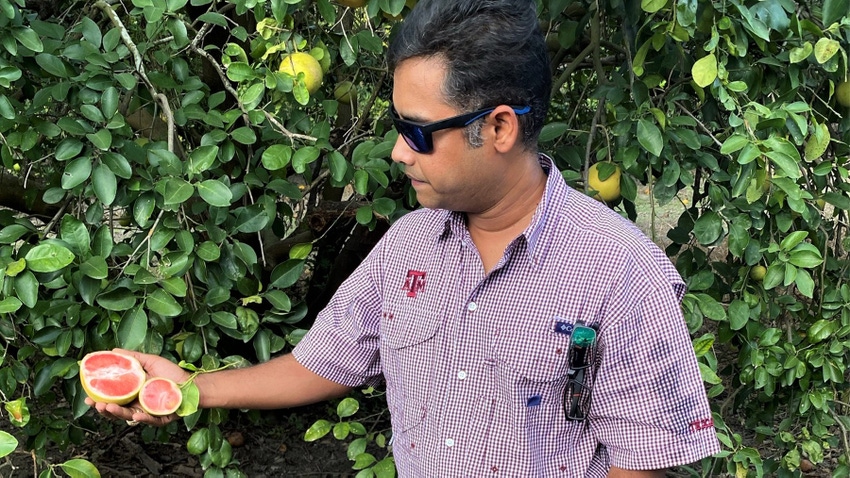August 1, 2023

Developing disease-resistant, high-quality improved crop varieties to benefit agricultural producers and consumers may seem like a “hairy” task, but Texas A&M AgriLife Research scientists may have gotten to the root of the issue.
A new biological technology that develops and multiplies disease-resistant citrus plants using “hairy roots” is under development by an AgriLife Research team led by Kranthi Mandadi. Mandadi is an AgriLife Research associate professor at the Texas A&M AgriLife Research and Extension Center at Weslaco and a faculty member of the Department of Plant Pathology and Microbiology and the Institute for Advancing Health Through Agriculture in Bryan-College Station.

Assay plate of “hairy roots” that may be used to develop improved varieties of citrus and other plants. (Texas A&M AgriLife photo)
At the root of their project is developing new ways to fight fastidious pathogens, which infect living plants and resist growth in a lab setting for study. One such fastidious pathogen causes citrus greening — a significant problem for the citrus industry.
Since 2021, Mandadi has spearheaded a $7 million U.S. Department of Agriculture National Institute of Food and Agriculture, multi-state Coordinated Agricultural Project that is also a designated NIFA Center of Excellence to combat citrus greening.
“Fastidious plant pathogens infect citrus, tomatoes, potatoes, grapes, peppers and other crops grown throughout Texas,” said Dirk Hays, Texas A&M AgriLife Center director at Weslaco. “Often transmitted by insect vectors, these disease agents are responsible for billions of dollars in agricultural losses yearly.”
A breakthrough in plant disease therapies
The U.S. Department of Agriculture estimates the citrus industry would prevent $3 billion in losses per year by controlling citrus greening alone.
In recent years, Mandadi and his team at Weslaco developed a breakthrough method as an alternative means to propagate fastidious bacteria responsible for citrus greening and other insect-vectored diseases such as potato zebra chip and tomato vein greening disease.
“We developed a technology that uses pathogen-infected host tissues to produce so-called ‘hairy roots’ that can serve as biological vessels for the propagation of these pathogens in the laboratory,” Mandadi said.
The hairy root screening technique has already led to the discovery of new antimicrobial peptides and chemicals with proven efficacy in plant materials, said Sonia Irigoyen, an AgriLife Research scientist who helped develop the hairy root technology.
“These antimicrobials, either singly or in combination, could be used as near- and long-term therapies to control citrus greening, potato zebra chip and tomato vein greening diseases,” she said.
Now, in their most recent study, Mandadi and his team investigated how to use this hairy root technique in plant transformation and bioengineering improved citrus.
Hairy root-based genetic engineering of citrus
Building on previous success, in their latest study called “Rhizobium rhizogenes-mediated hairy root induction and plant regeneration for bioengineering citrus,” recently published in the high-impact Plant Biotechnology Journal, Mandadi and his team showed proof of the concept of engineering citrus using hairy roots.
In addition to Mandadi and Irigoyen, study co-authors include Manikandan Ramasamy, Michelle Dominguez, and Carmen Padilla, all AgriLife Research scientists at Weslaco. The study was supported by grants from the U.S. Department of Agriculture, the Foundation for Food and Agricultural Research, Texas A&M AgriLife Research Insect-Vectored Disease Seed Grants, and the Institute for Advancing Health Through Agriculture.

Citrus plant regeneration from hairy roots. (Texas A&M AgriLife photo)
“Developing new plant varieties with improved genetics using conventional breeding or the latest bioengineering and CRISPR tools can be quite laborious, often taking multiple years,” Mandadi said. “The ability to overcome this bottleneck and improve this process, particularly for hardy, slow-growing, perennial trees like citrus, can be a game changer and a boon to producers and consumers.”
A more efficient, quicker method for breeding hardier citrus
In their most recent study, the researchers used R. rhizogenes to induce transgenic hairy roots from diverse citrus cultivars such as grapefruit, sweet orange, rough lemon and citron at efficiencies of 28% to 75%. This level of efficiency is at least twice — potentially greater — than those seen with previous methods for citrus transformation, making for a faster and less costly process.
After making sure a transgenic root had the proper genetics, the team was then able to regenerate and clone several identical, transgenic plants from it.
Ramasamy said while scientists have used multiple methods in the past to transform crops, the efficiency of genetic modification of tree crops like citrus has been challenging due to their slow growth and difficulties in regeneration.
“However, we were able to demonstrate a versatile R. rhizogenes-mediated hairy root induction, plant regeneration and clonal propagation approach that could be helpful for multiple bioengineering and gene-editing applications in citrus and other tree crops,” he said.
The proposed R. rhizogenes-mediated citrus hairy root induction, shoot regeneration and multiplication process achieved in about six months what typically took approximately 12-18 months using the previously described transformation method.
“This means we will be able to develop and multiply disease-resistant citrus plants using root tissue more quickly and get them established much faster than when using the previous approaches,” Mandadi said. “The entire throughput for developing more disease-resistant citrus and other plants will be greatly expedited.”
Mandadi said the hairy-root mediated transformation could benefit citrus producers in many ways by speeding the development of new varieties with superior disease resistance, as well as resilience to environmental stresses, increased production efficiency and improved nutritional quality.
“It will also benefit the consumer in that they can expect to continue to have a supply of their favorite fruits and other items with characteristics they find most appealing in their produce,” he said.
About the Author(s)
You May Also Like




